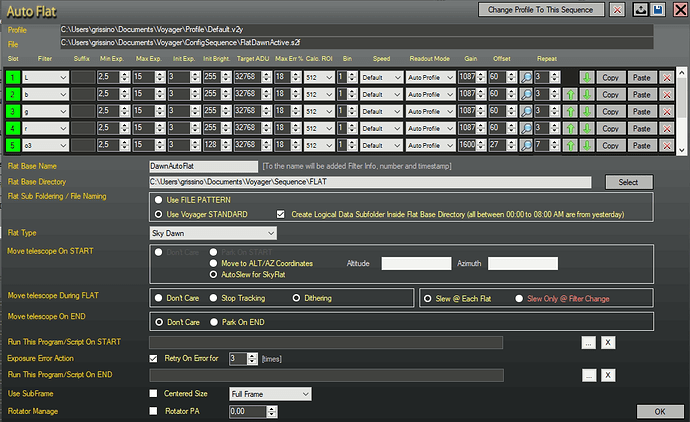I’m trying to get my flats with broadband filters for the first time. Apparently it seems that Voyager does not goes under 0.2 s of minimum exposure time so the ADU error is up to 9% and does not decrease. Is this a normal behavior?
Hi fukinagashi,
Time min depend on your camera driver and in exposure range in flat settings. Check this two things.
All the best
Leonardo
I can’t comment on your particular camera (Particularly not knowing what it is) but I can use 0.1 second or less exposures (ASI2600 camera)
In the flats sequence, I set the target ADU to generally 32K ADC, and I set the maximum error to 10% rather than the default 5%. It still produces really good flats but when shooting dusk and dawn flats it significantly reduces the number that Voyager has to recalculate and reshoot as the sky brightens or darkens. Pretty much every one after the initial default exposure per filter would be within 10% and saved, where 5% led to a lot of reshot ones in my location and I sometimes ran out of time.
Hi Paul and Fukinagashi,
min exposure absolute value of camera is determined by driver. You cannot go under. You can define the interval of min max exposure for flat in flat configuration but you cannot go under the absolute min value.
Generally better to not use too small ROI for flat calculation if you have big sensor and/or really not linear light decrease at corner (for example fast F ratio telescope). For CMOS camera you can use also the full frame if the sensor isn’t a monster sensor.
About the tollerance for my skyflat I use 18% of tollerance. Really important thing in this case is to normalize flat before doing rejection and median (I use CCDStack for this and its really simple).
This is My SkyFlat at Dawn, small number of flat for all filters … in few night I have a huge library of flat. I redo the master flat each 3 months with the last 3 months flats file. CMOS of actual generation do not need Dark Flat so I use the Bias for calibration (some older like the ASI 1600 sensor need dark flat).
For SkyFlat … absolutely do not use flats taken under heavy veils or cloudy sky.
All the best
Leonardo
Thanks Leonardo, your process is not dissimilar to mine. I use APP for image integration and it normalises flats before rejection and integration. Bias frames report an exposure time of 0, and when messing around before imaging I have sometimes shot images on the fly with very short exposures and can see that even well below 0.1 sec the result is as expected, so I assume the ASI driver works right down to 0 seconds.
I use the ASI2600 (I have both mono and OSC versions) and use the full frame for flat calculation as the download time is quick, and I am using in one case an F4 scope so there is some vignetting visible in the corners.
In case of 0 lenght exposure Voyager will use the min exposure time allowed by camera.
All the best
Leonardo
